
The Gulf of Finland is the easternmost arm of the Baltic Sea. It extends between Finland to the north and Estonia to the south, to Saint Petersburg in Russia to the east, where the river Neva drains into it. Other major cities around the gulf include Helsinki and Tallinn. The eastern parts of the Gulf of Finland belong to Russia, and some of Russia's most important oil harbors are located farthest in, near Saint Petersburg. As the seaway to Saint Petersburg, the Gulf of Finland has been and continues to be of considerable strategic importance to Russia. Some of the environmental problems affecting the Baltic Sea are at their most pronounced in the shallow gulf. Proposals for a tunnel through the gulf have been made.

Suomenlinna, or Sveaborg, is an inhabited sea fortress composed of eight islands, of which six have been fortified; it is about 4 km southeast of the city center of Helsinki, the capital of Finland. Suomenlinna is popular with tourists and locals, who enjoy it as a picturesque picnic site. Originally named Sveaborg, or Viapori as referred to by Finnish-speaking Finns, it was renamed in Finnish to Suomenlinna in 1918 for patriotic and nationalistic reasons, though it is still known by its original name in Sweden and by Swedish-speaking Finns.

The Finnish Army is the land forces branch of the Finnish Defence Forces. The Finnish Army is divided into six branches: the infantry, field artillery, anti-aircraft artillery, engineers, signals, and materiel troops. The commander of the Finnish Army since 1 January 2022 is Lieutenant General Pasi Välimäki.

The Utti Jaeger Regiment is the Finnish Army training and development centre for special forces and helicopter operations in charge of the Army Special Forces Unit and the Special Forces Qualification Course.
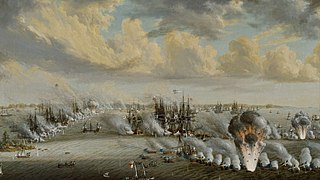
The Second Battle of Svensksund was a naval battle fought in the Gulf of Finland outside the present day city of Kotka on 9 and 10 July 1790. The Swedish naval forces dealt the Russian fleet a devastating defeat that brought an end to the Russo-Swedish War (1788–1790). The battle is the biggest Swedish naval victory and the largest naval battle ever in the Baltic Sea. It qualifies among the largest naval battles in history in terms of the number of vessels involved.

The Battle of Bomarsund, in August 1854, took place during the Åland War, which was part of the Crimean War, when an Anglo-French expeditionary force attacked a Russian fortress. It was the only major action of the war to take place at Bomarsund in the Baltic Sea.

Boden Fortress is a modern fortress consisting of several major and minor forts and fortifications surrounding the city of Boden, Norrbotten, in northern Sweden. The fortress was originally intended to stop or delay attacks from the east or coastal assaults, which at the time of construction meant Russian attacks launched from Finland. It was primarily the expansion of the railway net in Norrland, which in turn was a consequence of the rising importance of the northern iron ore fields, that led to the increased strategic value of northern Sweden and the construction of the fortress. Although the main forts were finished in 1908, many of the supporting fortifications were not completed until the start of the First World War. Improvements were also continuously made during, and between, both World Wars.
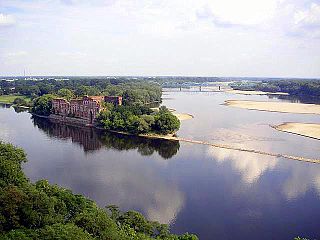
Modlin Fortress is one of the largest 19th-century fortresses in Poland. It is located in the town of Nowy Dwór Mazowiecki in district Modlin on the Narew river, approximately 50 kilometers north of Warsaw. It was originally constructed by the French from 1806 to 1812.

Warsaw Fortress was a system of fortifications built in Warsaw, Poland during the 19th century when the city was part of the Russian Empire. The fortress belonged to a chain of fortresses built in Congress Poland and the region adjacent to it during this period. It was built in stages, with the first part, known as Warsaw Citadel, built the years 1832-1834, in the immediate aftermath of the November Uprising of 1830. This initial fortification was then continually improved by the addition of further forts in its vicinity, with the work finally completed in 1874. In 1879 the government of the Russian Empire decided to carry out a major expansion of the fortress, which would incorporate a system of large forts surrounding the whole city. 20 forts forming this new system were constructed between 1883 and 1890. There were plans to combine the Warsaw fortress with the nearby Modlin Fortress by building a chain of connecting forts, but this work was carried out only partially. The rapid progress in the power of siege artillery required the forts to be continually strengthened. In the final period of its existence the fortress consisted of 29 forts and major works, including the older forts of the original Citadel, which were reinforced by numerous smaller fieldworks.

The Suomenlinna Church in Helsinki, Finland, was built in 1854 as an Eastern Orthodox garrison church for the Russian troops stationed at the Suomenlinna sea fortress. The fortress comprises five islands joined together by bridges, and the church is the central feature on the island of Iso Mustasaari, located at its highest point. It is surrounded by other fortress buildings, but the old parade ground is immediately to the east, and a park lies immediately to the south. It is oriented southwest to northeast so that it would align with the Crownwork Ehrensvärd defense front located to the southwest of the church.
Utti is a village in Valkeala, since 2009 a part of Kouvola, Finland. In 1918 General Carl Gustaf Mannerheim set up the first Finnish Air Force base in the village. Today, Utti is best known for the Utti Jaeger Regiment, a helicopter base and a training ground for special forces and military police, and civilian skydiving recreational activities.

The siege of Sveaborg was a siege by Imperial Russian forces of the sea fort of Sveaborg, off the coast of Helsingfors (Helsinki); at the time Finland was part of the Kingdom of Sweden. It took place in the spring of 1808, during the Finnish War. Despite its formidable reputation as "the Gibraltar of the North", the fortress surrendered after a siege of two months. As its capitulation was followed by the rapid collapse of Swedish resistance elsewhere, and ultimately the Russian conquest of Finland, the siege is often regarded as the decisive battle of the war.
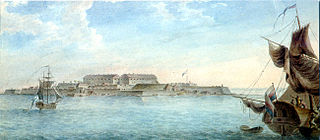
The Svartholm fortress was built between 1749 and 1764 outside Loviisa in Southern Finland by Augustin Ehrensvärd. The fortress, which lies at the mouth of the Bay of Loviisa, along with the planned land fortress at Loviisa, would have prevented invading Russian forces from entering what was then Swedish territory in present-day Finland.

The Krepost Sveaborg was an Imperial Russian system of land and coastal fortifications constructed around Helsinki during the First World War. The purpose of the fortress was to provide a secure naval base for the Russian Baltic fleet and to protect Helsinki and block routes to Saint Petersburg from a possible German invasion. Krepost Sveaborg was part of Peter the Great's Naval Fortress, a coastal fortification system protecting access to Saint Petersburg by sea. The central part of Krepost Sveaborg was the old fortress of Suomenlinna where the fortress headquarters were located. Due to technological advances in artillery the old fortress was no longer capable of providing a sufficient protection, and a new main defensive line was built well beyond the old fortress boundaries. New coastal artillery guns built on outlying islands protected Krepost Sveaborg from the sea, while fortified lines constructed around Helsinki were intended to stop any attacks on land. The primary coastal guns were 10 in (254 mm) model 1891 guns and 6 in (152 mm) model 1892 Canet guns. Older 11 in (279 mm) model 1877 guns were also used. In summer 1917 the fortress had two hundred coastal or anti-landing guns, of which 24 were 10-inch guns in six batteries, 16 were 6-inch Canet guns in four batteries and twelve were 11-inch guns in three batteries. The artillery used in land fortifications included older coastal guns, old fixed carriage guns and newer light field guns. In March 1917, Krepost Sveaborg had a total of 463 guns, although many of them were obsolescent. Krepost Sveaborg was still partly incomplete in 1917 when the February Revolution halted most of the construction work. Some further construction work was carried out during the remaining year, but all work halted during the October Revolution. Following the Finnish Declaration of Independence, parts of the land fortifications were used in the Finnish Civil War. The coastal fortifications were later taken over by Finland to protect Helsinki, while the land fortifications were mostly abandoned and disarmed.
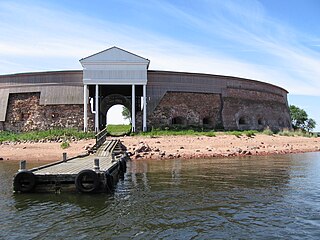
Ruotsinsalmi sea fortress is a fortification system in Kotka, Finland. It is part of the South-Eastern Finland fortification system built by Russia after Russo-Swedish War of 1788-1790. Ruotsinsalmi sea fortress formed the southern part of a double fortress together with Kyminlinna and it was built to counter the Swedish sea fortresses of Svartholm in Loviisa and Sveaborg (Suomenlinna) in Helsinki. Ruotsinsalmi also acted as an outpost of the Kronstadt sea fortress in Saint Petersburg. During the Crimean War, a British-French fleet destroyed the Ruotsinsalmi fortifications in 1855.

South-Eastern Finland fortification system is an extensive defensive system formed by three concentric fortress chains in South-East Finland built by Russia in the 1790s. The purpose of the fortification system was to protect the capital of the Russian Empire, Saint Petersburg, from a possible Swedish attack.
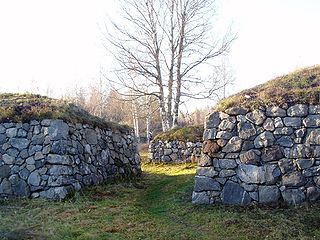
Kärnäkoski Fortress is a bastion fortress in Finland located in Kärnäkoski, Savitaipale built by Russia between 1791 and 1793 to protect Saint Petersburg.

The siege of Viborg took place in the spring of 1710 during the Great Northern War (1700–1721), as a second attempt by the Russians to capture the fortress port of Viborg, near the modern border between Russia and Finland, after a failed attempt in 1706. After the outbreak of the war, Swedish forces had fortified themselves in the port of Viborg. In order to assure safety for the newly founded city of Saint Petersburg, Peter the Great ordered the Swedish fort to be secured. A first unsuccessful attempt was made in 1706. Later plans were put on hold because of other ongoing conflicts but, after the Russian success at the Battle of Poltava in June 1709, the men and resources were available to capture the town.

Liikkala Fortress is a fortress in Kouvola, Finland. It was built in 1790s as a part of a larger South-Eastern Finland fortification system to protect Saint Petersburg, the capital of the Russian Empire.
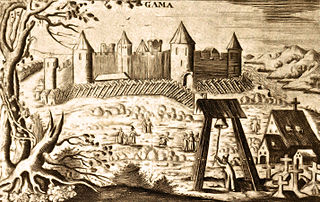
Yam is a fortress and heritage site located on the eastern bank of the Luga river in Kingisepp, Leningrad Oblast, Russia.



















